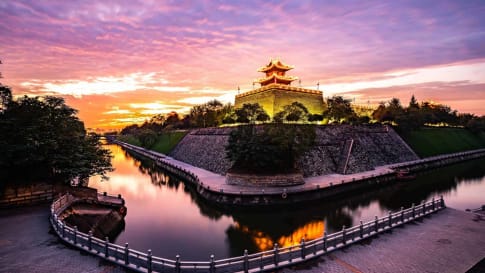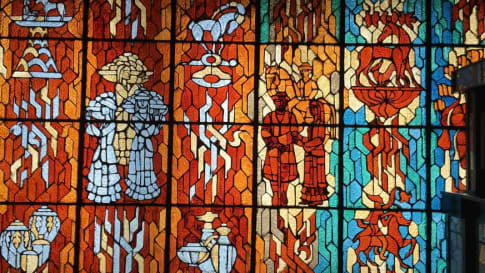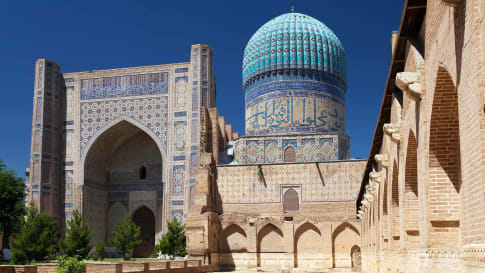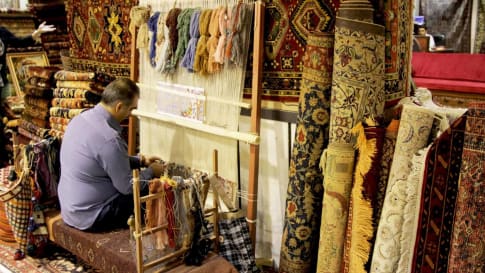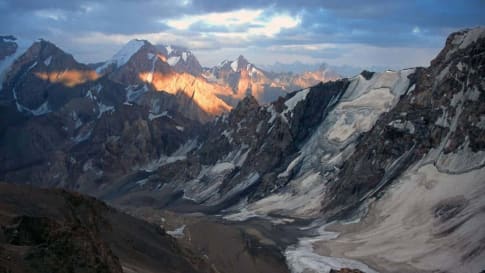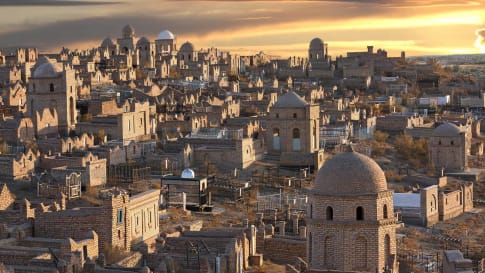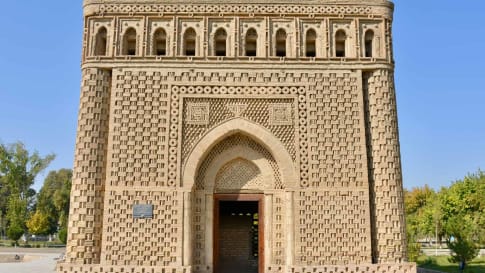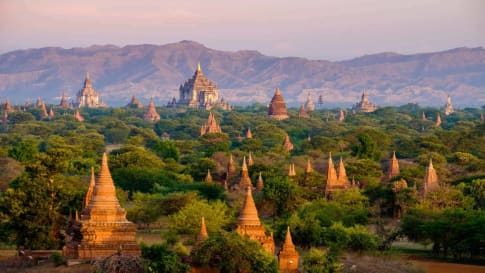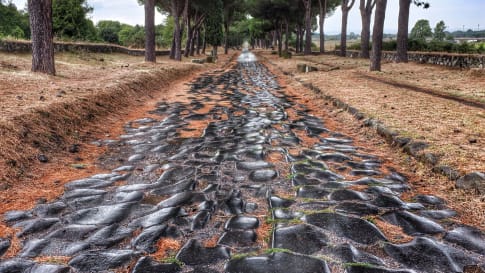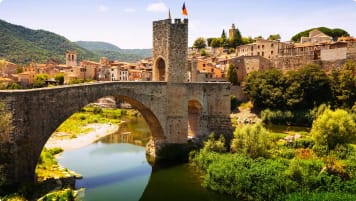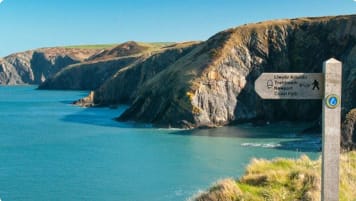Travel on the Silk Road of Central Asia | Small Group Tour for Seniors
The Silk Road is an ancient trade route linking China and Imperial Rome through Central Asia. Few areas in the world remain as unexplored or offer such richness in terms of ancient and modern history, culture, and scenic diversity as Central Asia. Our Small group Silk road tours itinerary explores the Road through remote deserts and mountainous environments as we visit key sites between Almaty and through to Samarkand over 31 days.
From A$22,985AUD
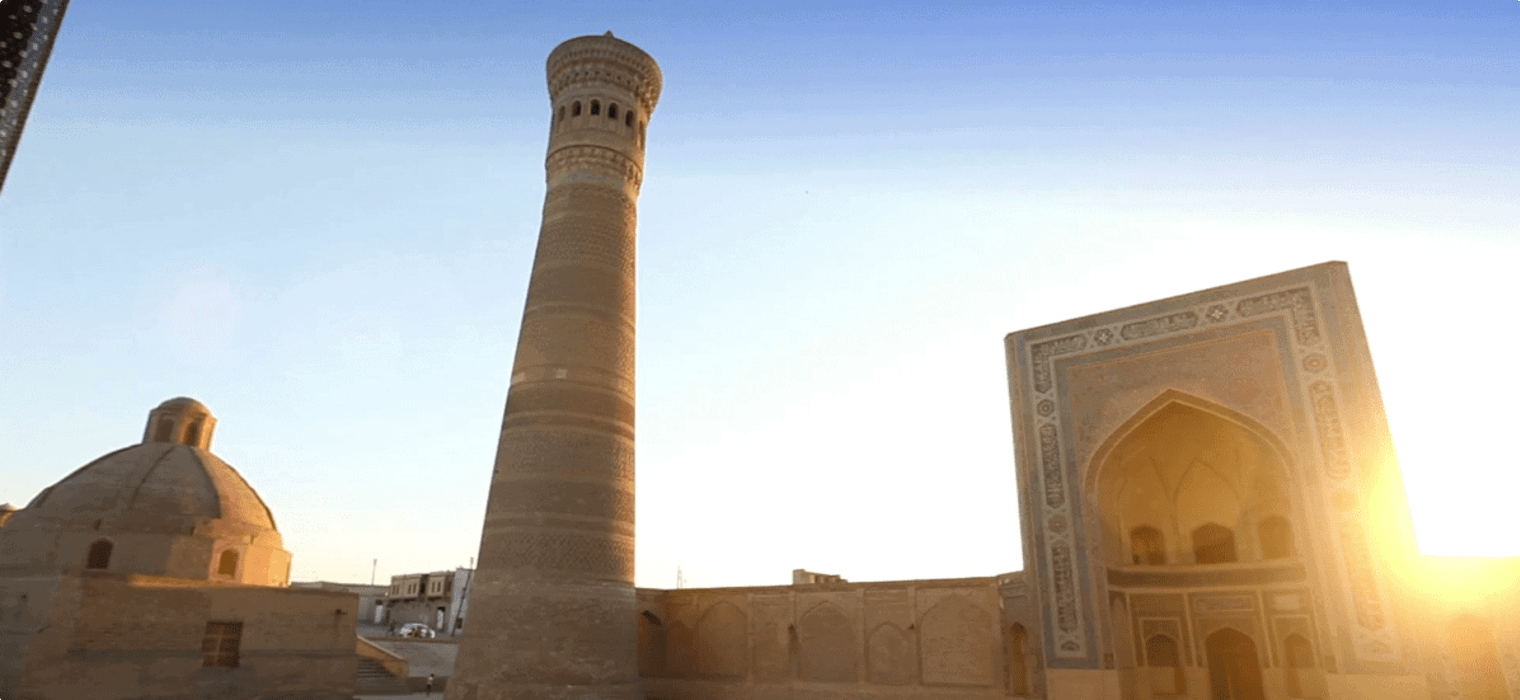
Highlights
- 1. Visit the Savistky Museum in Nukus and view the world's second largest collection of Russian avant garde art
- 2. Take in breathtaking views of the Tien Shan mountain range and Issyk Kul in Kyrgyzstan.
- 3. Explore Turkmenistan and the silk road history of Mary and Turkmenabat
- 4. Spend time in the fabled Silk Road cities of Bukhara and Samarkand, centres of religion, trade, and scholarship.
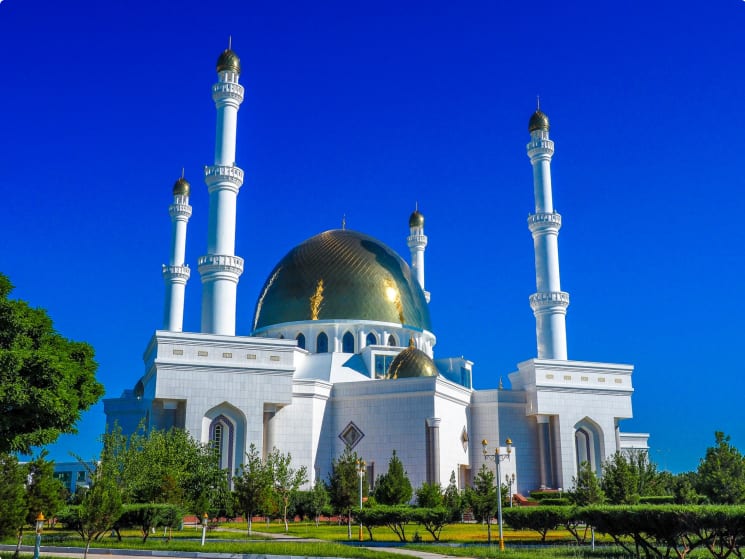
Departure Dates
| Departure Date | Price |
|---|---|
| 25 August 2025 Ends 24 September 2025 • 31 days A$22,985 Twin A$26,785 Single Available | Selected |
| 04 May 2026 Ends 03 June 2026 • 31 days A$22,985 Twin A$26,785 Single Available | |
| 24 August 2026 Ends 23 September 2026 • 31 days A$22,985 Twin A$26,785 Single Available | |
| 03 May 2027 Ends 02 June 2027 • days A$22,985 Twin A$26,785 Single Available | |
| 23 August 2027 Ends 22 September 2027 • days A$22,985 Twin A$26,785 Single Available |
Central Asia Silk Road Small Group Tour
Odyssey Traveller’s 31-day fully escorted small group Silk Road tours for seniors take you on a journey across the Eurasian steppe, tracing the ancient trade routes collectively known as the Silk Road. This guided small group tour is for couples and solo travellers, it follows the Silk road across Kazakhstan Uzbekistan and Turkmenistan. Some Silk road travel tours only offer the China Silk road tour, this is not one of themte.
The ancient Silk Road facilitated a two-way exchange of goods and ideas and led to the prosperity of cities supplying the routes’ ports and markets of trade. The UNESCO World heritage site has a full list of the Silk Road cities , which includes Guangzhou and Xi'an ( China ), Isfahan ( Iran ), Bukhara and Samarkand ( Uzbekistan ), Jeddah (Saudi Arabia), Baku(Azerbaijan), Almaty ( Kazakhstan ), and Venice (Italy), these emerging cities show today how the silk road an ancient world of adventure built ancient China and the regions beyond through the trade of desired goods in both directions. Marco Polo possibly was the first to describe the silk road an ancient world of adventure to his scribe sitting imprisoned in Genoa revealed much about the Silk road route and its importance to both East and the West. But the Roman empire centuries before showed how silk exceeded the price of gold and was the must have fabric for both sexes, until it was outlawed for men to wear Chinese silk.
This guided tour will take you to the Silk Road cities and important stops in Kazakhstan(to reach the Silk Road border post of Naryn),Kyrgzstan, Uzbekistan and Turkmenistan give deeper knowledge of the Silk Road’s incredible legacy. The history of it is amazing, as are the explorers and archeologists of the Silk Road who in the 19th century had the opportunity to explore and uncover the legacy of silk road travel over the centuries on a unique section of the road in central asia.
Odyssey Traveller’s Silk Road tours from Australia, USA and Britain explores how diverse cultures from both east and west, north and south, have shaped this region for over 2,000 years. We will be accompanied throughout the tour by an Odyssey Program Leader. In Uzbekistan, there will be English-speaking national guides throughout. Local guides will also be present along the way to assist in the interpretation and presentation of information. This tour is designed for the active senior traveller keen on learning more about history, viewing incredible scenery, and embarking on a unique adventure. To prepare you for this tour we have prepared a reading of list books on the Silk road to read before you join the tour in Almaty.
Itinerary for Central Asia Silk Road Tour Itinerary
This tour commences in Almaty, Kazakhstan. The group then heads east to Kegen, where shortly after the group crosses the border and head across to Naryn where we pick up the central line of the Silk road. We continue our journey to Uzbekistan, where we stay in the fascinating Silk Road cities on the trade route of Bukhara through to Khiva, Nukus and then onto Turkmenistan. In Turkmenistan the group stops and explores what where ancient cities such as Urgench, now Konye- Urgench with is UNESCO world heritage buildings. Travels to the capital Ashgabat before going North to Mary and Turkmenabat and up to Bakhara, Samarkand. Our final stop on this version of the Silk road tours is Tashkent, capital of Uzbekistan, where the tour concludes its journey for this small group ion the ancient trading route.
You can learn more about Turkmenistan and Uzbekistan with our country profiles. For more details about this Silk Road Tour, click the ‘Top 5’ or ‘Itinerary’ buttons above! If you’re keen to experience this tour, please call or send an email. Or, to book, simply fill in the form on the righthand side of this page.
Gallery

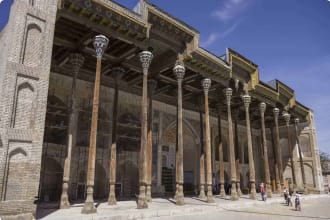

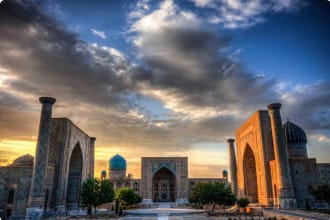
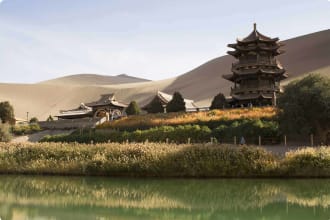
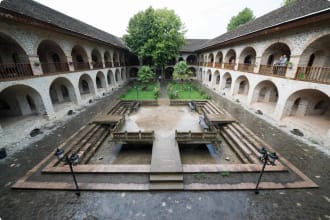
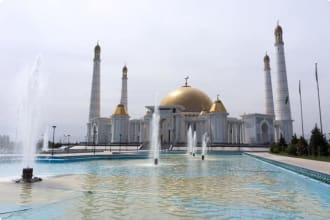
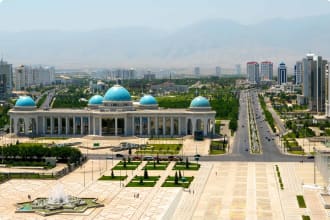
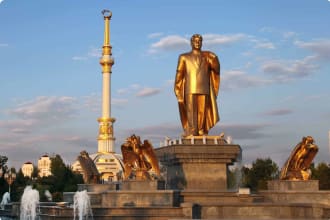
Itinerary
31 days
Day 1: Almaty
Accommodation: Almaty: TBA
Almaty is Kazakhstan’s largest city and its main transport hub and centre of industry and education. It served as capital of the former Kazakh Soviet Socialist Republic (1929–91) and of independent Kazakhstan (1991–97) before the capital was moved to Nur-Sultan. Almaty means “Father of Apples” due to the abundance of apple trees in the region.
Almaty became one of the trade, craft and agricultural centres on the Silk Road and possessed an official mint around the 10th century.
Upon arrival in Almaty, we make our own way to our hotel. We will start our tour with an introductory meeting in the late afternoon, followed by a welcome dinner. (D)
Day 2: Almaty
Accommodation: Almaty: TBA
After breakfast, we will meet with our local guide at the hotel lobby for the start of our city tour. Today we will visit the Green Bazaar where we could taste local cuisine and take part in (or simply watch) the cooking and preparation of national delicacies. We will visit monuments such as the Park of 28 Panfilov Guardsmen, named after General Ivan Panfilov who led 28 soldiers who stopped the offensive of Nazi German tanks in Moscow during World War II; the Ascension Cathedral, built by architect Andrei Zenkov, famous as a founder of earthquake-proof construction; and the Kazakh Museum of Folk Musical Instruments showcasing traditional musical instruments from Kazakh culture, as well as instruments of Turkish, Uzbek, and Kyrgyz origins.
We will have lunch with a Kazakh family in order to sample authentic Kazakh cuisine and learn some of Kazakh traditions.
In the afternoon, we continue our sightseeing and visit the Central Mosque constructed in the Timurid style of architecture. We will watch a folk show at Gakku Restaurant, and continue on to Republic Square, the heart of Almaty, where the main festivities, events and demonstrations are held, and the Central State Museum of Kazakhstan, established in 1931, one of the oldest and largest museums of Central Asia.
We will head to the Sunkar Falconry Centre for Golden Eagle Show to see several species of eagles and other birds of prey and learn more about this bird sanctuary.
We will continue the tour with a visit to Kok-Tobe Hill (“Green Hill”), the highest point in the city, located at a height of 1100 meters above sea level. We will have dinner and enjoy an amazing view of Almaty city at sunset.
Day 3: Almaty
Accommodation: Almaty TBA
We have a half day tour of the city. We explore the legacy of Soviet art in this city as well as other unique stories of the city. This afternoon is at your leisure.
Day 4: Kegen
Accommodation: Kegen; TBA
Today we depart for Kegen. Kegen is the stopping point for the day.
Day 5: Karakol
Accommodation: Karakol; TBA
Today we cross the border into Kyrgzstan and spend the morning heading to Karakol. This afternoon we visit the local museum
Day 6: Karakol
Accommodation: Karakol; Tba
Today our guide shares we us the unusual history of the city from the ancient to the role of the soviets. This morning we stop to visit Prjevalsky Museum followed by lunch at a local café. We then visit the Russian Orthodox Church and the Dungan Mosque, built in a Buddhist pagoda style in wood without a single nail. Later we return to our hotel. (B,L,D)
Day 7: Issyk Kul
Accommodation: Royal Beach Resort or similar
Today we visit the Cholpan Ata Bazaar and view rock drawings dating from the 1st century BC to the 7th century AD. We will have an excursion to the Petroglyphs’ Museum which contains a number of prehistoric monumental structures and petroglyphs dating from the 2nd millennium BC up to the Middle Ages up to the 6th century.
We break at Issyk Kul, a lake in the northern Tian Shan mountains and a significant resting point on the northern branch of the Silk Road. In the Kyrgz language, its name means “warm lake” because it never freezes. It is the second largest saline lake after the Caspian Sea.
(B,L,D)
Day 7: Naryn
Accommodation: Khan-Tengri Guest House or similar
This morning we drive to Naryn.
During this trip we will pass many fields full of wild horses and have fantastic views of the Tian Shan Mountains. En route to Naryn we will pause to view an old caravanserai. Caravanserai are roadside inns that dotted the Silk Road to provide a place for travellers to rest and recover. The name was derived from the Persian compound word karvansaray (combining karvan “caravan” with saray “palace”). These inns were built with a central open-air courtyard to protect Silk Road merchants and travellers against brutal weather conditions such as heavy snow and freezing temperatures.
On arrival in Naryn we will transfer to our hotel, and spend the remainder of the day at our leisure. Naryn is a small town yet untouched by mass tourism, and will offer solace as we rest after the long journey. (B,L,D)
We arrive in Naryn in the afternoon.
Day 8: Bishkek
Accommodation: Park Hotel or similar
Today we have an early morning departure for Bishkek, the capital of the Republic of Kyrgyzstan, located 400 kilometres to the west of Issyk Kul. En route, we pause at Burana, the ruins of a 9th to 11th century caravan town from the period of the Turkic Karakhanid Dynasty. We will view the surviving Burana tower and the nearby archaeological museum. We arrive at Bishkek in time for a late lunch. After lunch, we have a short orientation regarding Bishkek, a modern city with vast squares, crowded bazaars, impressive administrative centres, and educational institutions. Bishkek was captured by the Russians in 1862. It became the administrative centre of the Kyrgyz autonomous province (later re-named the Kyrgyz Autonomous Soviet Socialist Republic) in 1924, and like other former Soviet Union republics declared its independence in 1991 upon the dissolution of the USSR. As the major industrial centre of the republic, Bishkek’s factories produce leather goods, agricultural machinery, and a variety of textiles. We will visit the History Museum and the Tsum (Soviet-period supermarket). Dinner will be at a local restaurant, accompanied by traditional music. (B,L,D)
Day 9: Bishkek - Ala Archa - Bishkek - Tashkent
Accommodation: City Palace Hotel or similar
After breakfast, we transfer to Ala-Archa Canyon, famous for its perpetual snow stretching for 200 kilometres. This unique alpine national park is one of the main attractions in Kyrgyztan and is located not far from Bishkek. The park, which includes the gorge of the Ala-Archa River and the mountains surrounding it, is famous for its beauty. It is also home to a number of rare plants and birds. “Ala-Archa” means “many-coloured juniper” after the trees found in abundance in the area. After a walk in Ala-Archa National Park, we return to Bishkek for lunch at a local cafe, before making our way to the airport for our evening flight to Tashkent, the capital of Uzbekistan. On arrival, we are transferred to our hotel. (B,L,D)
Day 10: Tashkent
Accommodation: Tashkent.
There is a morning walking tour around Tashkent. The afternoon is at your leisure.
We return to this city towards the end of the tour to explore in detail.
Day 11: Tashkent - Khiva
Accommodation: Asia Khiva Hotel or similar
We have a very early start today as we head back to the airport for a flight to Khiva. Khiva is on the Amu-Darya, the longest of the 2 rivers that run east to west across Central Asia, and so has a long history of agriculture in an otherwise arid environment. It was also a trading post and on a minor branch of the Silk Road trading route.
We arrive in Khiva around lunch time. After a break our local guide takes on a tour of what commentators call ‘open air museum’ consisting of the Dichan Kala outer town and the Ichan Kala inner town. The town is protected by a 2.2 km-long sloping brick wall, the foundations of which were laid in the 10th century.
Following Tamerlane’s (Timur) plundering and destructive campaigns of the late 1300s, Khiva became capital of Korozem khanate. Its inner city is packed with many religious buildings and buildings from past rulers. (B,L,D)
Day 12: Khiva
Accommodation: Asia Khiva Hotel or similar
We spend the day exploring this amazing city. We visit Kalta Minor Minaret, the Kunya ark fortress with administrative buildings, gunpowder works, law courts, mosque, the Pakhlavan Makhmud complex, the most remarkable architecture memorial complex in Khiva with unique tiles, and Ak-Sheikh Baba Observation platform. This morning we visit the Islam Khodja Complex, consisting of the city’s smallest madrassah and tallest minaret, ringed with stripes of lustrous blue tiles. Visit the oldest architectural structure in Khiva, the 14th century Sheikh Said Allauddin Mausoleum.
After lunch at a local restaurant we continue our sightseeing and visit Islam Khodja minaret, built in 1908 it is the highest building In Khiva. Djuma Mosque, cathedral mosque with a roof which lies on 212 wooden fretted columns and lastly we visit Tash Hovli Palace, the summer residence of Khiva Khans, built in the 19th century. (B,L,D)
Day 13: Nukus
Accommodation: Nukus; TBA
Today we make the journey to Nukus. On arrival we’ll be met and take a sightseeing tour of the city with a visit to the Savitsky Art Museum, which houses the second most valuable collection of paintings by the Russian avant-garde artist Igor Savistky. We’l also visit an Embroidery centre of Gulnara Egamberdieva and a local yurt making family.
Day 14: Nukus
Accommodation: Nukus; TBA
Walking tour of Nukus. This afternoon we drive to the Igor Savitsky Museum (Karalpak Museum). This remarkable museum, opened in 1966, is located in the most remote region of Uzbekistan and houses an enormous collection, including antiquities from Khorezm traditional Karakalpak folk art, Uzbek fine art and, uniquely, the largest collection of Russian avant-garde art in the world after the Russian Museum in St Petersburg.
Free time to further explore the Savitsky Museum at your own pace.
Day 15: Konye-Urgench
Accommodation: Konye-Urgench; TBA
Today the group travels into Turkmenistan.
Day 16: Ashgabat
Accommodation: Ashgabat; TBA
.
Day 17: Ashgabat
.
Day 18: Ashgabat
Today is at your leisure.
Day 19: Mary
We travel to Mary and explore the region including the ancient historic city of Merv.
Evidence indicates Merv was once the world’s largest city. Located in Turkmenistan at the crossroads of trade routes, it rose up out of a green oasis, offering a welcome respite from its vast desert surrounds. Historians believe Merv was inhabited from the sixth century BC, but there are traces of life here from as far back as the 3rd millennium BC. In Merv, the Murghab River filtered across a network of canals, and the land is thought to have been fertile and green with trees. Merv was a major stop on the Silk Road, the region boasting production of high quality cotton favoured by textile dealers. Once a metropolis, its bare bones yield clues into the extent of the city’s cultural and religious significance.
Merv is a UNESCO world heritage site.
Day 20: Mary
We continue with our local guide to explore Mary and the ancient city of Merv.
Day 21: Turkmenabat
Today the group travels north to Turkmenbat.
Day 22: Turkmenabat
Accommodation: Turkmenabat;TBA
Our local guide has a full day exploring the ancient path of the silk trade routes of the region.
Day 23: Bukhara
Today the group travels across the border to Uzbekistan. We are based in Bukhara for the next few days. This morning, we travel by coach to Bukhara, an ancient city and prominent stop on the Silk Road. In addition to being a trade stop, Bukhara also served as a major centre of Islamic theology, scholarship, and culture. UNESCO has listed the city’s historic centre, home to numerous mosques and madrasas (educational institutions), as a World Heritage Site.
Day 24: Bukhara; TBA
Accommodation: Bukhara; TBA
A second day in this world heritage city exploring its rich and vibrant history. We start our sightseeing with the Ark of Bukhara, a fortress built in the 5th century, followed by the Ismoil Somoni Mausoleum. We pause for lunch at a local restaurant and continue our sightseeing afterwards. We will visit the Poikalon complex, which consists of three structures: Minorai Kalin, Masjidi Kalon and Miri Arab Madrassah. Next, we explore the Labi Havz, which translates as “ensemble near the pool”. There are three monumental structures here, too: the Kukeldash Madrassah, Nadir Devanbegi Madrassah and Nadir Devanbagi Khanaka, all of which date from the 16th century. Finally, we pay a visit to the Maggoki Attari Mosque, before retiring for dinner and an Uzbek dance show. (B,L,D)
Day 25: Bukhara
Accommodation: Bukhara; TBA
Today is at your leisure.
Day 26: Bukhara - Giduvan - Samarkand
Accommodation: Registan Plaza Hotel or similar
Today we travel by coach to Samarkand, which like Bukhara was a great Silk Road city and a centre for Islamic scholarship. The city centre is on the World Heritage List. En route we will visit Sitora-i-Mokhikhosa, the Summer Palace of the Former Emir of Bukhara. En route we stop to at the small town of Gijduvan to see the traditional pottery works of Alisher. Lunch will be with Alisher’s family. We arrive at our hotel in Samarkand in the early evening for dinner. (B,L,D)
Day 27: Samarkand
Accommodation: Registan Plaza Hotel or similar
We have a morning tour including a visit to Ulugbek’s Observatory, Afrosiab Museum and archaeological sites and Shahi Zinda Necropolis, a series of intricately designed tombs continually constructed over many centuries. After lunch at a local restaurant we continue our sightseeing with Registan Square to see the three beautiful madrasas, Shirdor, Ulugbek, and Tilla Kari followed by a visit to Gur Emir Mausoleum. Dinner will be at a local Uzbek family home. (B,L,D)
Day 28: Samarkand - Shakre Sabz - Samarkand
Accommodation: Registan Plaza Hotel or similar
Today we will go on an excursion to Shakre Sabz, the birthplace of the Turkic conqueror Tamerlane (Timur). Of Mongol ancestry and known in history as a brutal warrior, Tamerlane established a vast empire in the 14th century, which included Turkistan, Afghanistan, Persia, Syria, southern Russia, and India. Under his reign, Samarkand became a beautiful city as Tamerlane was an eager patron of art and scholarship. His empire did not survive after his death in 1405. We will see the ruins of Tamerlane’s summer residence, the Ak Saray Palace; Dorus Tilavat Seminary, Kok Gumbaz Mosque and Dorus Saidat. Lunch will be at a local restaurant and later in the afternoon we return to Samarkand (approx. 3hrs drive). Dinner will be at the hotel. (B,L,D)
Day 29: Samarkand – Tashkent
Accommodation: City Palace Hotel or similar
We have a free morning in Samarkand for personal sightseeing or resting. We check-out of the hotel at noon and have lunch at a local restaurant. We’ll enjoy a little more sightseeing including visit to the Bibi Khanum Mosque and Siab Bazaar. In the late afternoon we are transferred to the trains station and catch the high-speed train to Tashkent. On arrival in Tashkent we will be transferred to our hotel. We will have dinner in a local restaurant. (B,L,D)
Day 30: Tashkent
Accommodation: City Palace Hotel or similar
After having our fill of Samarkand, we will now turn our attention to the capital of Uzbekistan, Tashkent. This city boasts of more than 2,000 years of written history. In 1219, Tashkent was destroyed by Genghis Khan, but was rebuilt and became prosperous from profits brought by the Silk Road. Its name is derived from the Persian word for “city” (chach). After the 16th century, the name evolved from Chashkand to Tashkand. The modern spelling “Tashkent” reflects 20th-century Soviet influence. Developments in the city after the 1991 dissolution of the Soviet Union sought to replace icons from the Soviet era, such as the statue of Lenin now replaced with a structure of a globe, called the Monument of Independence of Uzbekistan. This morning we will visit Hast Imam complex, Barak Khana, and the Tila Shaikh Mosque and archives. Later we proceed to Chorsu Bazaar, Kukeldesh Madrassah and the History Museum and a ride on the Tashkent Metro, its stations are among the most ornate in the world. Lunch will be at a local restaurant. In the afternoon we will be taken to the Navoi Theatre and shall see the day’s performance, pending their schedule. Tonight we will be treated to a farewell dinner at a local restaurant. (B,L,D)
Day 31: Tashkent
Our tour concludes after breakfast, however we may offer optional activities if the group flight is scheduled for an evening departure, such as a visit to the Fine Arts Museum, Amir Timur Museum and Park during the afternoon. Note: A transfer to the airport is included if all participants are departing at the same time (flight details will be advised approximately 60 days prior to start date of the tour) (B)
Includes / Excludes
What’s included in our Tour
- 31 nights of hotel accommodation.
- 31 breakfasts, 23 lunches, and 26 dinners.
- Internal flight sectors are included as per itinerary, economy class.
- Touring in best available air-conditioned coaches.
- All transfers and porterage (1 bag per person) while on tour (day 2 to Day 18) except in local airports where porterage is usually not available.
- Comprehensive sightseeing tours with English speaking guides, including all entrances fees throughout.
- Tipping and gratuities.
- Services of a Tour Leader.
What’s not included in our Tour
- International airfares and departure taxes.
- Comprehensive international travel insurance.
- Visa fees, where required.
- Meals on the trains.
- Arrival and departure transfers (start/end) of tour.
- Items of a personal nature eg. Drinks, telephone calls, laundry.
Participants must be in excellent health, extremely mobile and live an active lifestyle. Program activities may include up to 6 hours of continuous strenuous, moderate-to-fast paced activities per day on varied terrain.
Book now
Make it a private tour
Easing your journey
Crossing international borders with restrictions
The list of requirements to travel internationally has changed and will continue to change for several years. Odyssey is here to assist you in managing your way through these requirements:
For more information see our Crossing international borders with restrictions page.
Book With Confidence
If less than 30 days before your tour starts you are unable to travel as a result of Government travel restrictions, Odyssey Traveller will assist you with a date change, provide you with a credit or process a refund for your booking less any non-recoverable costs.
See Terms and conditions for details.
Peace of Mind Travel
The safety of our travellers, tour leader, local guide and support staff has always been our top priority and with the new guidelines for public health and safety for keeping safe for destinations around the world, we’ve developed our plan to give you peace of mind when travelling with us.
See Peace of Mind Travel for details.
Reading List Download PDF
Foreign Devils on the Silk Road
Hopkirk, Peter
The Silk Road, which linked imperial Rome and distant China, was once the greatest thoroughfare on earth. Along it traveled precious cargoes of silk, gold and ivory, as well as revolutionary new ideas. Its oasis towns blossomed into thriving centers of Buddhist art and learning. In time it began to decline. The traffic slowed, the merchants left and finally its towns vanished beneath the desert sands to be forgotten for a thousand years; however, legends grew up of lost cities filled with treasures and guarded by demons. In the early years of the last century foreign explorers began to investigate these legends, and very soon an international race began for the art treasures of the Silk Road. Huge wall paintings, sculptures and priceless manuscripts were carried away, literally by the ton, and are today scattered through the museums of a dozen countries. Peter Hopkirk tells the story of the intrepid men who, at great personal risk, led these long-range archaeological raids, incurring the undying wrath of the Chinese.
The Silk Roads: A New History of the World
Peter Frankopan
The sun is setting on the Western world. Slowly but surely, the direction in which the world spins has reversed: where for the last five centuries the globe turned westwards on its axis, it now turns to the east.
For centuries, fame and fortune was to be found in the west in the New World of the Americas. Today, it is the east which calls out to those in search of adventure and riches. The region stretching from eastern Europe and sweeping right across Central Asia deep into China and India, is taking centre stage in international politics, commerce and culture and is shaping the modern world.
This region, the true centre of the earth, is obscure to many in the English-speaking world. Yet this is where civilization itself began, where the world's great religions were born and took root. The Silk Roads were no exotic series of connections, but networks that linked continents and oceans together. Along them flowed ideas, goods, disease and death. This was where empires were won and where they were lost. As a new era emerges, the patterns of exchange are mirroring those that have criss-crossed Asia for millennia. The Silk Roads are rising again.
A major reassessment of world history, The Silk Roads is an important account of the forces that have shaped the global economy and the political renaissance in the re-emerging east.
The Silk Road: A Very Short Introduction
James A. Millward
The phrase "silk road" evokes vivid images: of merchants leading camel caravans over deserts and steppes to trade exotic goods in the bazaars of glittering Oriental cities, of pilgrims braving bandits and frozen mountain passes to gather scriptures and spread their faith across continental expanses. Beyond the exotica, however, this VSI will be a sketch of the historical background against which the silk road flourished, and an essay on the significance of old-world intercultural exchange to Eurasian and world history generally. On the one hand, Millward treats the silk road broadly, as a metonym for the cross-fertilizing communication between peoples across the Eurasian continent since at least the Neolithic era. On the other, he highlights specific examples of goods and ideas exchanged between the Mediterranean, Persian, Indian, and Chinese regions, along with the significance of these exchanges. While including silks, spices, travelers' tales of colorful locales, the main focus of the book is to outline the dynamics of Central Eurasian history that promoted silk road interactions, especially the role of nomad empires; and to highlight the importance of the biological, technological, artistic, intellectual, and religious interchanges across the continent. Millward shows that these exchanges had a profound effect on the old world that was akin to, if not yet on the scale of, modern globalization.
Millward also considers some of the more abstract contemporary uses to which the silk road concept has been put. It is, of course, a popular marketing device for boutiques, museums, restaurants, and tour operators from Venice to Kyoto. More than that, however, the silk road has ideological connotations, used sometimes to soften the face of Chinese expansion in Central Asia, or, in the US culture wars, as a challenge to the "clash of civilizations" understanding of intersocietal relations. Finally, while it has often been argued that the silk road declined or closed after the collapse of the Mongol empire or the opening of direct maritime communications from Europe to Asia, Millard disputes this view, showing how silk road phenomena continued through the early modern and modern expansion of Russian and Chinese states across Central Asia.
Foreign Devils on the Silk Road: The Search for the Lost Treasures of Central Asia
Peter Hopkirk
The Silk Road, which linked imperial Rome and distant China, was once the greatest thoroughfare on earth. Along it travelled precious cargoes of silk, gold and ivory, as well as revolutionary new ideas. Its oasis towns blossomed into thriving centres of Buddhist art and learning.
In time it began to decline. The traffic slowed, the merchants left and finally its towns vanished beneath the desert sands to be forgotten for a thousand years. But legends grew up of lost cities filled with treasures and guarded by demons. In the early years of the last century foreign explorers began to investigate these legends, and very soon an international race began for the art treasures of the Silk Road. Huge wall paintings, sculptures and priceless manuscripts were carried away, literally by the ton, and are today scattered through the museums of a dozen countries.
Peter Hopkirk tells the story of the intrepid men who, at great personal risk, led these long-range archaeological raids, incurring the undying wrath of the Chinese.
The Silk Road - Central Asia, Afghanistan and Iran: A Travel Companion
Jonathan Tucker
Stretching from the ancient Chinese capital of Xian across the expanses of Central Asia to Rome, the Silk Road was, for 2,000 years, a vibrant network of arteries that carried the lifeblood of nations across the world. Along a multitude of routes everything was exchanged: exotic goods, art, knowledge, religion, philosophy, disease and war. From the East came silk, tea, jade, paper, porcelain, spices and Buddhism; from the West, horses, weapons, lions, precious stones and cotton. From its earliest beginnings in the days of Alexander the Great and the Han Dynasty, the Silk Road expanded and evolved, reaching its peak under the Tang and Byzantine empires and gradually crumbling along with the decline of the Mongol empire. In this beautifully-illustrated book, which covers the Central Asian section of the Silk Road - from Lake Issy Kul through Tashkent, Samarkand, Bukhara, the Kyzyl Kum Desert, Khiva and Merv to Herat, Kabul and Iran - Jonathan Tucker uses traveller’s anecdotes and a wealth of literary and historical sources to celebrate the cultural heritage of the countries that lie along the Silk Road and illuminate the lives of those who once travelled through the very heart of the world.
China's Asian Dream: Empire Building along the New Silk Road
Tom Miller
"China", Napoleon once remarked, "is a sleeping lion. Let her sleep, for when she wakes she will shake the world." In 2014, President Xi Jinping triumphantly declared the lion had awakened. Under his leadership, China is pursuing a dream to restore its historical position as the dominant power in Asia.
From the Mekong River Basin to the Central Asian steppe, China is flexing its economic muscles for strategic ends. By setting up new regional financial institutions, Beijing is challenging the post-World War II order established under the watchful eye of Washington. And by funding and building roads, railways, ports and power lines—a New Silk Road across Eurasia and through the South China Sea and Indian Ocean—China aims to draw its neighbours ever tighter into its embrace.
Combining a geopolitical overview with on-the-ground reportage from a dozen countries, China’s Asian Dream offers a fresh perspective on the rise of China’ and what it means for the future of Asia?
The Silk Road in World History
Xinru Liu
The Silk Road was the contemporary name for a complex of ancient trade routes linking East Asia with Central Asia, South Asia, and the Mediterranean world. This network of exchange emerged along the borders between agricultural China and the steppe nomads during the Han Dynasty (206 B.C.E.-220 C.E.), in consequence of the inter-dependence and the conflicts of these two distinctive societies. In their quest for horses, fragrances, spices, gems, glassware, and other exotics from the lands to their west, the Han Empire extended its dominion over the oases around the Takla Makan Desert and sent silk all the way to the Mediterranean, either through the land routes leading to the caravan city of Palmyra in Syria desert, or by way of northwest India, the Arabian Sea and the Red Sea, landing at Alexandria. The Silk Road survived the turmoil of the demise of the Han and Roman Empires, reached its golden age during the early middle age, when the Byzantine Empire and the Tang Empire became centres of silk culture and established the models for high culture of the Eurasian world. The coming of Islam extended silk culture to an even larger area and paved the way for an expanded market for textiles and other commodities. By the 11th century, however, the Silk Road was in decline because of intense competition from the sea routes of the Indian Ocean. Using supply and demand as the framework for analysing the formation and development of the Silk Road, the book examines the dynamics of the interactions of the nomadic pastoralists with sedentary agriculturalists, and the spread of new ideas, religions, and values into the world of commerce, thus illustrating the cultural forces underlying material transactions. This effort at tracing the interconnections of the diverse participants in the transcontinental Silk Road exchange will demonstrate that the world had been linked through economic and ideological forces long before the modern era.


